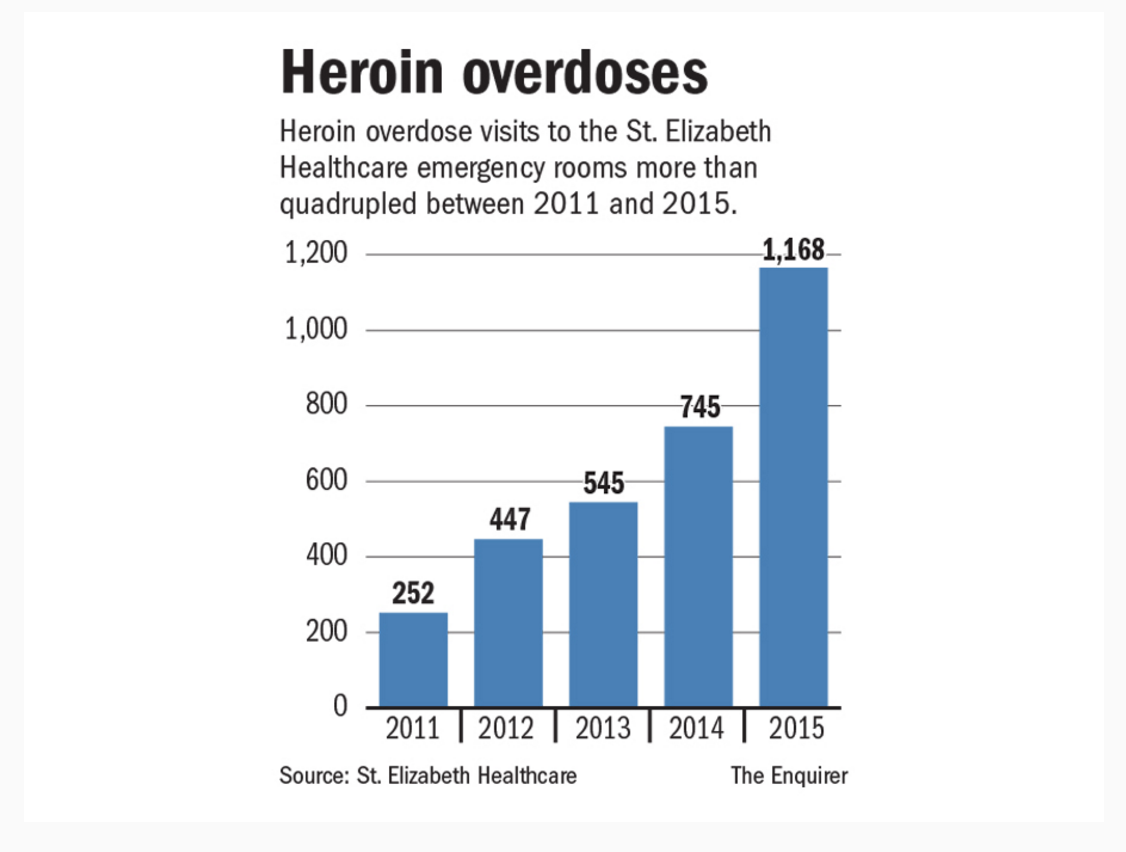It started about three years ago with briefs about vigils for people who died from heroin overdoses. Terry DeMio saw them now and then. One day, a coworker at The Cincinnati Enquirer mentioned that someone in her neighborhood had a heroin addiction.
“I just remember thinking there was something to this,” said DeMio, who was then a general assignment reporter.
So she called a hospital system in Northern Kentucky, St. Elizabeth Healthcare, and told the spokesperson about what she was seeing. He connected DeMio with a physician. On one particular day, that doctor told her, about a third of his patients were addicted to heroin or linked to someone who was. It was the first time DeMio heard the term “heroin epidemic.”
She started writing about heroin for both the Enquirer and its northern Kentucky edition, unsure at the beginning if the term epidemic even applied.
Three years later, she’s quite sure.
Her work, which spans the last three years, includes solo pieces, joint projects. Last month, her editor turned DeMio’s coverage of heroin into a beat. Now, instead of writing between three and four general assignment stories per week, she has the time and space to pull back and look at the bigger picture.
“I’m trying to broaden and deepen all the time,” DeMio said, “and this is what gives me time to do that.”

From The Cincinnati Enquirer’s “Heroin ODs soar in 2015 in NKY.”
It’s everywhere
In the last year and a half, Enquirer editor Peter Bhatia has lived in three different cities — Portland, Oregon, Phoenix, Arizona and now Cincinnati.
“And in all three very different places, the heroin epidemic is a huge, huge problem,” he said.
When Bhatia started last year, he got to know DeMio’s reporting and saw that they had a reporter who was connected to the community and understood the problem.
“As we tweaked our beats here and made some adjustments, it was just really clear to me that we needed to devote a full-time person to it,” he said.
Most news organizations are covering heroin now because it’s a huge issue that no one can escape, Bhatia said. For the Enquirer, focusing one person on the issue makes sense, he said.
“The notion of the paper of record is a lovely one that’s completely out of date and out of our reach. It does mean that we have to decide not to cover some things as thoroughly as we might have.”
But it also means there are areas they’re choosing to cover thoroughly and deeply, he said.
“Any editor can tell you that there are way more issues to cover than we can actually get to, but my focus here has been making sure that we’re doing the most important things really well and in-depth, and in that context, heroin certainly rises to standing on its own as a beat.”
Small stories vs. big ones
Heroin in 2016 is being covered and talked about in a very different way than crack and cocaine was in the 80s, said David Tuller, academic coordinator of the University of California, Berkeley’s joint masters program on public health and journalism.
“It’s very telling that when it’s one drug more associated with one racial group, it’s covered one way,” Tuller said.
Last August, Atlantic contributing editor Andrew Cohen highlighted the disproportionate attention paid to heroin in an article called “How White Users Made Heroin a Public-Health Problem.”
Some experts and researchers see, in the different responses to these drug epidemics, further proof of America’s racial divide. Are policymakers going easier today on heroin users (white and often affluent) than their elected predecessors did a generation ago when confronted with crack addicts who were largely black, disenfranchised, and economically bereft? Can we explain the disparate response to the “black” heroin epidemic of the 1960s, in which its use and violent crime were commingled in the public consciousness, and the white heroin “epidemic” today, in which its use is considered a disease to be treated or cured, without using race as part of our explanation?
While crack and cocaine was covered from a law enforcement perspective, heroin is now often covered from a public health perspective. Crime stories are individual, Tuller said. Health stories are systematic.
“That suggests very different solutions from a policy perspective,” he said. “When you cover it from a public health systems perspective, then you have to deal with the systems that are making it more likely.”
Tuller, who covered health for 10 years at The San Francisco Chronicle, shared these tips for approaching stories from a public health perspective:
- Focus on the landscape. “Don’t just focus on the one individual person or the one individual story,” he said. “But try to get a sense of what’s going on around the country. Why this is happening in multiple places at the same time?”
- Look for what’s behind it.
- Shift your framework.
- Make sure individual stories have important context.
Look at the research to see what’s driving an epidemic. “What are the larger forces that are driving it? Figure out a way to illustrate those.”
“Don’t think of it as a crime problem so much,” Tuller said. “Think of it as a societal health problem.”
Individual stories help put a face on an issue, but stories of people who’ve beaten the odds and recovered on their own tell us only about that person’s willpower. “What are the systems that make this more possible or prevent from happening?” That’s harder to illustrate, Tuller said, but much more telling. “One of the challenges of reporting about health issues or addiction issues is that individual portraits are so compelling for us as stories, but an individual story in science means nothing.”
Reaching out
To cover her new beat, DeMio looks at heroin through several lenses — individual, health, law enforcement and societal. Her work includes solutions and accountability. And she’s part of two private Facebook groups made up of the parents of heroin addicts and a support group for heroin addicts.
“I find myself reading and rereading what they’re saying, what they’re going though, to inform myself,” she said.
She’s also used her work to try to de-stigmatize Medication-Assisted Treatment, or MAT, which, she reports, “curbs withdrawal and cravings and also blocks the heroin high.”
In 2014, the paper received the Award of Excellence in Public Health from the Northern Kentucky Independent District Health Department. The award came with the following citation:
As print journalism evolves in the 21st Century, newspapers are increasingly taking on an activist role in community issues. The Cincinnati/Kentucky Enquirer’s coverage of the heroin epidemic in Northern Kentucky and Greater Cincinnati has been instrumental in bringing attention and resources to the issue. Thus, the newspaper has been selected as the winner of this year’s Award of Excellence in Public Health.
Through her coverage, DeMio’s trying to help people build a language for coping with heroin addiction and expectations for how to deal with it in loved ones. People also contact her seeking advice and connections. She once got a call from a woman whose daughter was in jail and going through withdrawal. DeMio connected the woman with a doctor who worked at the jail. That doctor let the woman know her daughter was getting treatment. It’s not a role DeMio trained for as a journalist.
“But I think this is an important direction for all of us,” she said.
DeMio doesn’t expect that role or her beat to change anytime soon.
“I think that in the last six months or so, there has been an awakening that, oh yes, this really is an epidemic, and that we have got to move and move quickly,” DeMio said. “But I do not believe that we are anywhere near to catching up with it.”
“People are dying,” she said, “and it’s too entrenched for it to be stopped anytime soon.”







